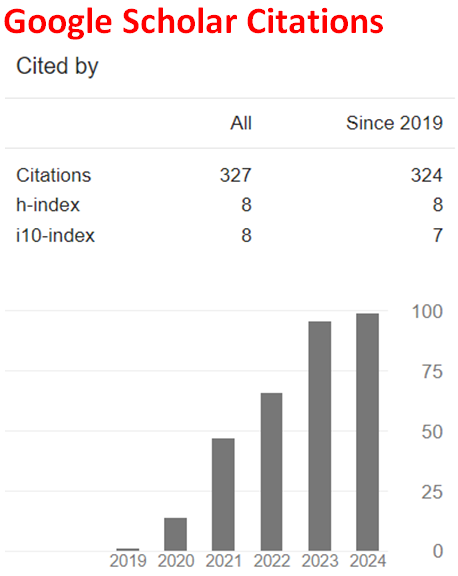Moroxydine Tautomers - A DFT Treatment
Abstract
Moroxydine is an orally active non-nucleoside type antiviral agent of biguanide structure. Biguanides constitute an important class of therapeutic agents suitable for the treatment of a wide spectrum of diseases. In the present density functional study (B3LYP/6-311++(d,p)) tautomers of moroxydine have been investigated within the constraints of the theory and the basis set employed. Moroxydine may exhibit 1,3- and 1,5-type proton tautomerism. Presently, all those possible tautomeric forms are considered. All the tautomers are electronically stable and have thermo chemically favorable formation values at the standard conditions. Some quantum chemical and spectral properties of those tautomeric systems have been obtained and discussed. The effect of tautomeric variations on the chemical function descriptors have been determined. Also, the variation of polar surface areas of the tautomers have been considered in relation to their ability to penetrate the blood-brain barrier.
Downloads
References
Yu, X-B., Chen, X-H., Ling, F., Hao, K., Wang, G-X., & Zhu, B. (2016). Moroxydine hydrochloride inhibits grass carp reovirus replication and suppresses apoptosis in Ctenopharyngodon idella kidney cells. Antiviral Research, 131, 156-165. https://doi.org/10.1016/j.antiviral.2016.05.008
Sheppard, S. (1994). Moroxydine: the story of a mislaid antiviral. Acta Dermato-Venereologica, 74(183), 1-9. PMID: 9868507. https://doi.org/10.2340/0001555518319
Gasparini, R., Amicizia, D., Lai, P.L., Bragazzi, N.L., & Panatto, D. (2014). Compounds with anti-influenza activity: present and future of strategies for the optimal treatment and management of influenza. Part II: future compounds against influenza virus. J. Prev. Med. Hyg., 55, 109-129. PMID: 26137785; PMCID: PMC4718316.
Gasparini, R., Amicizia, D., Lai, P.L., Bragazzi, N.L., & Panatto D. (2014). Compounds with anti-influenza activity: present and future of strategies for the optimal treatment and management of influenza. Part I: influenza life-cycle and currently available drugs. J. Prev. Med. Hyg., 55, 69-85.
Magri, A., Reilly, R., Scalacci, N., Radi, M., Hunter, M., Ripoll, M., Patel, A.H., & Castagnolo, D. (2015). Rethinking the old antiviral drug moroxydine: discovery of novel analogues as anti-hepatitis C virus (HCV) agents. Bioorganic Med. Chem.Lett., 25, 5372-5376. http://dx.doi.org/10.1016/j.bmcl.2015.09.029
Schersten, B. (1959). Herpes zoster treated with N’,N-anhydrobis (2-hydroxyethyl)- biguanide HC1 (ABOB). Svenska Lakartidningen, 56, 3563-3566. PMID: 14442681.
Nasemann, T. (1962). Virustatic effect of a heterocyclic biguanide on herpes simplex virus in vitro. Der Hautarzt, Zeitschrift fur Dermatologie, Venerologie, und verwandte Gebiete, 13, 182-5. PMID: 14478421.
Sjoberg, B. (1960). Experiments on prophylaxis and suppression of epidemic influenza with NSN1 anhydrobis (b-Hydroxyethyl) biguanide hydrochloride (ABOB). A double blind study. Antibiotic Med., 7, 97-102.
Kaji, M., Kamiya, S., Tatewaki, E. Nagafuch, Z., & Fujiwara, N. (1966). Effect of N1,N1-anhydrobis-(b-hydroxyethyl) biguanide hydrochloride (ABOB) against adenovirus. Chemotherapy, 14, 66-68. https://doi.org/10.11250/chemotherapy1953.14.66
Kaji, M., Kamiya, S., Fujiwara, N., Mitsuuch, J., Hirayama, S., Nagayama, T., Mieno, K., Nishio, S., Nunoue, K., Funatsu, I., Shingu, T., Takajo, N., & Takenaka, T. (1966). Clinical evaluation of N1-N1-anhydrobis (β-hydroxyethyl) biguanide hydrochloride in the treatment of pharyngoconjunctival fever. Chemotherapy, 14, 69-71. https://doi.org/10.11250/chemotherapy1953.14.69
Ishida, N. (1965). Virus inhibitory activity of biguanides and related compounds. Ann. N. Y. Acad. Sci., 130(1), 460-468. https://doi.org/10.1111/j.1749-6632.1965.tb12582.x
Kleinschmidt, H. (1962). Trials with ABOB for prevention and therapy of measles and chickenpox. Munch Med. Wochenschr., 104, 2294-2296. PMID: 14033435.
Martinon, J., & Baran, L. (1964). A case of chickenpox during the virustat era. Bull. Soc. Fr. Dermatol. Syphiligr., 71, 92-3. PMID: 14184757.
Bonnet, J., Calas, E., Florens, A., & Castelain, P.Y. (1963). Action du virustat en dermatologie [Action of virustat in dermatology]. Bull Soc Fr Dermatol Syphiligr., 70, 677-9 (in French). PMID: 14119349.
An, M., Yi, D., Qiu, J., Liu, H., Hu, S., Han, J., Guo, Y., Huang, H., He, H., & Wang, P. (2020). Measurement and correlation for solubility of moroxydine hydrochloride in pure and binary solvents. Journal of Chemical & Engineering Data, 65(5), 2611-2618. https://doi.org/10.1021/acs.jced.0c00015
Fan,Y., Gao, Z.Z., Zhao, W.X., Chen, S-Y., Xi, Y-Y., Gao, R-H., Xiao, X., & Tao, Z. (2017). Supramolecular assemblies of moroxydine hydrochloride and cucurbit[7,8]uril. J. Incl. Phenom. Macrocycl. Chem., 87, 21-28. https://doi.org/10.1007/s10847-016-0671-7
Skrzypek, S. (2011). Electrochemical study of moroxydine and its voltammetric determination with a silver amalgam film electrode. Electroanalysis, 23(12), 2781-2788. https://doi.org/10.1002/elan.201100343
Lu, L., Gao, X., Zhu, M., Wang, S., Wu, Q., Xing, S., Fu, X., Liu, Z., & Guo, M. (2012). Exploration of biguanido–oxovanadium complexes as potent and selective inhibitors of protein tyrosine phosphatases. Biometals, 25, 599-610. https://doi.org/10.1007/s10534-012-9548-4
Kathuria, D., Bankar, A.A., & Bharatam, P.V. (2018). What's in a structure? The story of biguanides. Journal of Molecular Structure, 1152, 61-78. https://doi.org/10.1016/j.molstruc.2017.08.100
Grytsai, O., Myrgorodska, I., Rocchi, S., Ronco, C., & Benhida, R. (2021). Biguanides drugs: Past success stories and promising future for drug discovery. European Journal of Medicinal Chemistry, 224, 113726. https://doi.org/10.1016/j.ejmech.2021.113726
Stewart, J.J.P. (1989). Optimization of parameters for semi empirical methods I. J. Comput. Chem., 10, 209-220. https://doi.org/10.1002/jcc.540100208
Stewart, J.J.P. (1989). Optimization of parameters for semi empirical methods II. J. Comput. Chem., 10, 221-264. https://doi.org/10.1002/jcc.540100209
Leach, A.R. (1997). Molecular modeling. Essex: Longman.
Kohn, W., & Sham, L.J. (1965). Self-consistent equations including exchange and correlation effects. Phys. Rev., 140, 1133-1138. https://doi.org/10.1103/PhysRev.140.A1133
Parr, R.G., & Yang, W. (1989). Density functional theory of atoms and molecules. London: Oxford University Press.
Becke, A.D. (1988). Density-functional exchange-energy approximation with correct asymptotic behavior. Phys. Rev. A, 38, 3098-3100. https://doi.org/10.1103/PhysRevA.38.3098
Vosko, S.H., Wilk, L., & Nusair, M. (1980). Accurate spin-dependent electron liquid correlation energies for local spin density calculations: a critical analysis. Can. J. Phys., 58, 1200-1211. https://doi.org/10.1139/p80-159
Lee, C., Yang, W., & Parr, R.G. (1988). Development of the Colle-Salvetti correlation energy formula into a functional of the electron density. Phys. Rev. B, 37, 785-789. https://doi.org/10.1103/PhysRevB.37.785
SPARTAN 06 (2006). Wavefunction Inc. Irvine CA, USA.
Hitchcock, S.A., & Pennington, L.D. (2006). Structure-brain exposure relationships. J. Med. Chem., 49 (26), 7559-7583. PMID: 17181137. https://doi.org/10.1021/jm060642i
Shityakov, S., Neuhaus, W., Dandekar, T., & Förster, C. (2013). Analysing molecular polar surface descriptors to predict blood-brain barrier permeation. International Journal of Computational Biology and Drug Design, 6 (1-2), 146-56. PMID: 23428480. https://doi.org/10.1504/IJCBDD.2013.052195

This work is licensed under a Creative Commons Attribution 4.0 International License.


